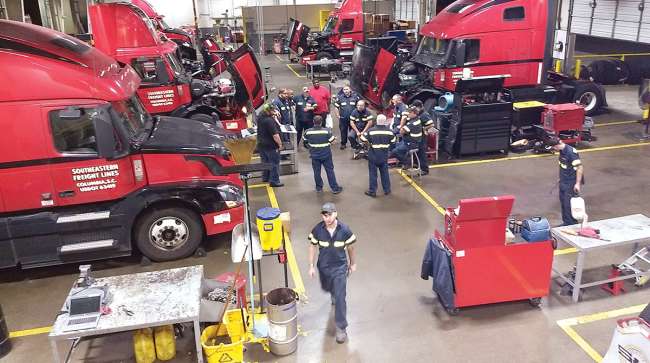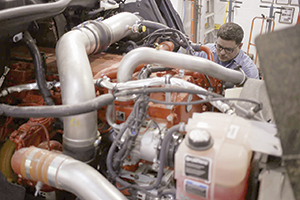Maximizing Truck Maintenance

[Stay on top of transportation news: Get TTNews in your inbox.]
Manufacturing first embraced Lean and Six Sigma techniques — tools and strategies to improve business processes — in the 1980s, and the concepts are gaining ground in truck maintenance shops. Those in the trucking industry who have applied Lean or Six Sigma processes said they can cut waste and increase their shops’ efficiency.
The distinction between Lean and Six Sigma has gotten blurred, but traditionally, Six Sigma has focused on reducing process variation and enhancing process control while Lean has emphasized eliminating waste.
Greg Schuttenhelm, chief operating officer of Portland, Ore.-based TEC Equipment, a truck and trailer dealership, said Six Sigma is a framework for prioritizing, scoping out opportunities and bringing the real experts — employees, vendors and customers — to the table to solve problems and make better decisions. The company uses Six Sigma techniques regularly.
Paccar Leasing has implemented Six Sigma techniques throughout shops at company-owned PacLease locations, said Sally Rosamond, a Six Sigma dedicated “black belt” for Paccar Leasing.
Lean and Six Sigma strategies involve several steps, such as creating a hypothesis, defining the problem, measuring, analyzing and improving. “Our primary project goals are to make the working environment safer and more efficient while reducing variability in our processes,” Rosamond said. “By using Six Sigma methods, we lower the water level to see the ‘rocks,’ the areas where we can make improvements.”

A PacLease technician works on a truck. Paccar Leasing uses Six Sigma techniques. (PacLease)
When deciding where to start, Brandon Uzarek, field engineer for truck component manufacturer Accuride Corp., suggests shops look at their past challenges and opportunities and apply the Pareto principle. That’s a Lean/Six Sigma theory that states that 80% of the effects come from 20% of the causes.
“Normally, the top 20% of your concerns are 80% of your cost savings,” he said. “If you knock out the worst first, you’re going to save yourself quite a bit of money,” Uzarek said, adding that shop managers can look at the repairs they conduct most often. “Everybody has a different problem that is costing the most money or giving them the most trouble with their Pareto principle, but it is all how they work through that to achieve the best return.”
Southeastern Freight Lines began the process of implementing Lean techniques in its shops in 2016 due to requests to hire more technicians to meet maintenance demands. “Most of these requests were submitted without any real justification as to why, other than excessive downtime on units waiting to be repaired,” said Lee Long, director of fleet services.
Lexington, S.C.-based Southeastern Freight Lines ranks No. 30 on the Transport Topics Top 100 list of the largest for-hire carriers in North America.
Many people are using Lean techniques already in their everyday lives, said Randy Obermeyer, terminal manager for Batesville Logistics Inc. However, Obermeyer said the lingo used in Lean/Six Sigma could get in the way of adoption.
“If you start talking that language at the shop floor to the techs and overcomplicate the processes, they turn off and don’t want anything to do with it,” he said.
Obermeyer draws on the simplest Lean tools to make technicians think about what they’re doing and why. He starts by having technicians ask why until they think through a problem. The strategy, often called the “Five Whys in Six Sigma,” helps technicians find the root cause of an issue.

Lean or Six Sigma processes can boost maintenance shop efficiency, industry experts say. (Bloomberg News)
For example, when a technician is changing batteries, Obermeyer respectfully asks why he is doing it. “He says, ‘Because they are dead.’ I ask, why it was dead,” he explained.
He added that through asking why multiple times, the technician may discover the batteries died due to a loose connection because it wasn’t tightened according to Technology & Maintenance Council recommended practices, which led to it being discharged beyond recharge.
Obermeyer said he calls this process Go See, Ask Why, Show Respect.
“You get to the root cause, which could be anything from manufactured defects that qualify for warranty, to driver abuse that leads back to third-party billing or a failed repair. They all lead to teaching opportunities and ideas of how we can prevent these issues going forward,” he said.
Accuride’s Uzarek said a fishbone diagram, called the Ishikawa diagram, helps operators find the root cause of a problem.
“You write down all of the factors that could be affecting the issue under those fish bones, and you go through them one at a time and cross them off,” he said, adding that the issue could be caused by man, material, method, machine, measurement or environment.
When implementing Lean techniques, Southeastern Freight Lines started with a full review of its preventive maintenance schedules using a team of regional managers, shop managers and technicians. That led to a refined PM checklist that provided the most efficient steps to complete each level of PM.
“We learned that as the technology of the equipment was becoming more reliable, that our older PM schedules could be modified or extended and not impact the longevity of the life of the unit in the fleet,” Long said, adding that the fleet created a training video it rolled out to technicians to ensure a consistent PM process across its system.
In 2017, Southeastern Freight Lines initiated a major computerized maintenance system that enabled it to deploy standard job times for technicians and create a scorecard on technicians’ technical expertise, tooling opportunities and the overall ability to schedule or forecast the work coming into shop locations. The fleet now monitors standard repair times and provides feedback to technicians.
Compliance with set standards allowed the fleet to not only go from lengthy out-of-service times to just-in-time repairs, but also enabled the fleet to bring in outside work to ensure technicians are working and not concerned about being shorted hours or staff reductions, Long said.

Rick Tapp, director of maintenance at PacLease (center), reviews new maintenance procedures developed, in part, through Six Sigma. (PacLease)
When needed, PacLease engages in large-scale Six Sigma efforts to address significant operational challenges, which it did when it experienced growth that put a shop at capacity. “The location was unsure how to manage the growing volume of work without a major shop expansion,” Rosamond explained.
PacLease put together a Six Sigma high impact “kaizen” event, which is a highly focused improvement project designed to increase efficiency. “After a few weeks of intensive work with the respective shop, the team was able to optimize multiple processes and re-layout the shop and truck lot. The shop was able to add the needed capacity without the costs of new construction,” she said.
The PacLease shop saw an overall reduction in completion time for preventive maintenance, a 16% increase in in-house repairs and a 12% improvement in shop capacity.
“By changing the shop layout and having the high-volume parts and tools readily accessible, there was a reduction in wasted motion,” Rosamond said. “It reduced the time to do a PM by as much as 20 minutes, depending on the job.”
Tracking movements can uncover inefficiencies, and several Lean/Six Sigma tools can identify wasted steps.
Batesville’s Obermeyer said shops could benefit from a swim-lane chart, which can identify how many times someone in the maintenance shop, for example, goes to a different department. “That is potentially wasted motion or time that you can eliminate,” he said.
A spaghetti diagram can track where technicians go when they leave the bay. “Maybe he goes to the parts room for an oil filter, then over to another area of the shop to turn on the air that feeds the oil pump,” Obermeyer said. “Maybe he had an issue getting the filter off, so he has to go to the tool department to get a tool, or then something strips out and has to go to the parts room again. If he always has to go to the parts room for filters, let’s move the filters next to the PM bay.”
Accuride’s Uzarek said measuring progress is essential.
“If you don’t know where you were, you don’t know where you are going, and you don’t know what you’ve achieved,” he said.
TEC Equipment uses formal tools for capturing projects, assigning value to those projects, and prioritizing based on the strongest combination of four factors — business impact, time to complete, resources required and the likelihood of success.
“The real trick is to identify the most important inputs to a process and track the things that lead to quality outcomes,” Schuttenhelm said.
When engaging in a Lean or Six Sigma project, Schuttenhelm said it is critical to include technicians and employees impacted by any improvement efforts so they are directly involved and vested in the outcomes.
“To optimize any process, you need to harness and leverage the expertise of the people that do the work every day and know the most about it,” he said.
Obermeyer suggested fleets see Lean as a journey rather than a destination.
“You will never reach the end of Lean. You’ll always continue to search for savings,” he said.
Want more news? Listen to today's daily briefing:



